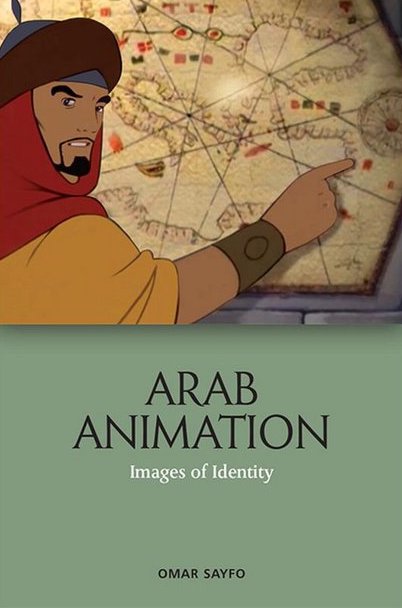Review of Omar Sayfo, Arab Animation: Images of Identity, Edinburgh: Edinburgh University Press, 2021.
Probably the first extensive dedication to the subject, Arab Animation: Images of Identity is a major contribution to the diverse world of Arab and international animation production. The book provides the reader with a good and rather detailed overview of the evolution of Arab animation throughout the years. The author states that his book considers ‘authorship claimed by Arabs, including diaspora communities’ (p. 5) and that his goal is to ‘explore how Arab animated cartoons mediate and negotiate notions of identity’ (p. 4), both visually and through language and narrative. Researching animation archives and contemporary animation production, the author writes about animation in a variety of Arab countries, including Egypt, Algeria, Iraq, Jordan, Kuwait, the Palestinian Territories, Qatar, Syria, Saudi Arabia, Tunisia, and the United Arab Emirates.
After an introduction, where the author clarifies contested terminology and defines the scope of the book, Arab Animation discusses the negotiation of different types of Arab identity formation via animation, examining them via the lenses of the ‘national’, the ‘critical national’, the ‘pan-Arab’, ‘the Islamic’ and the ‘revolutionary’. More precisely, Chapter 2 deals with animation produced in Egypt, Jordan, UAE, the Palestinian territories, and Tunisia (all countries whose production companies primarily address domestic issues and a ‘national’ audience) and discusses how these works represent discourses around subjects of national scope. These productions are aligned with the identity politics of their funders and, among others, produce content that justifies their formal histories, legitimacy, and struggles. Animations discussed include the Egyptian animations Mafish faida (1936), wherein was first introduced the character Mish Mish Effendi (see Figure 2), and Bakkar (1998), UAE’s Freej (2006), and the Tunisian Viva Carthago (2005). The author explains how, in these productions, the narrative, the visual representation of the self and the environment, as well as the language used highlight the differentiation from other Arab identities and foreigners.
Chapter 3 revolves around Arab animated sitcoms and the representation of national identities. It discusses how, since the mid-2000, the sitcom genre became popular in the Arab world and resulted in the production of several such humorous adult animations. It is particularly interesting to read about how these sitcom animations adopted the basic principles of the genre, such as pop culture and mild socio-political references, but adapted them to their tastes and sensitivities and had them undergo direct and indirect censorship (p. 106).
Chapter 4 discusses the representation of pan-Arab identities in animation. It does so by following the production in countries that proclaimed pan-Arab objectives such as Iraq under Saddam Hussain and post-1990s Syria and by subsequently, discussing projects created by transnational organizations with a pan-Arab stance and pan-Arab satellite channels. The author presents the differences and commonalities of various approaches to the idea of pan-Arabism and analyses the means the creators chose to pursue their objectives, which include among others promoting a shared culture, history and broad topography as well as the suppression of distinct national and foreign elements.
Chapter 5 focuses on the portrayal of Islamic identities in animation. It analyses animated cartoons of Islamic content by Golf and Saudi production companies, Egyptian animation that aligns with religious content, and a Kuwaiti American production that addresses children of the Muslim diaspora. These animations share the same overall theme and the use of Fusha Arabic, which is also the language of the Qur’an. Yet, they differ regarding visual style, which is unique to the tastes and approaches of each author. Here, once more, the ‘Self’ and the ‘Other’ are dressed by visual and narrative methods that evoke sympathy or antipathy among the audience. Particularly engaging is the divergent representation of the ‘Islamic’ in the disparate national settings and political agendas of the regimes these animations are produced in.
Arab Animation ends with an exploration of what the author describes as the ‘Arab animation spring’. The latter is described as the result of a creative wave of young individuals who, with the use of cheaper animation means of production and the Internet, managed from 2008 onwards to bypass the traditional production hierarchies and negotiate revolutionary notions of Arab identity.
Finally, in the epilogue, the author examins Arab animations’ potential for global outreach, focusing primarily on the Saudi and Emirati production Bilal (2015). He ends the book by recognizing that new ways of distribution and transnational collaborations and exchange of knowledge may eventually challenge the current world dominant models and produce Arab animations of a universal appeal (p. 252).
Arab Animation is an important addition to the scholarly study of world animation production and a good record of Arab animation production in different countries. The only point I found problematic was the occasional and rather casual negative evaluation of the artistic style of certain animations based on dominant animation aesthetics. I would recommend the addition of this book to any library and film/animation study center that aims to support further research and animation production of a non-Western origin. I would also encourage organizations with an agenda and interest to preserve global, and in particular Arab art and animation, to consider the creation of an archive, perhaps an online one, that could allow the public to watch and study the animation mentioned while ensuring that these examples remain in popular memory.
Dr. Myria Christophini Njenga is a Scottish and Cypriot animator, visual artist, and researcher. Her research is a practice-led investigation into creative communication avenues among people in conflict and aims to be a platform for people to voice issues that matter to them, such as mental health, loneliness, or anxiety. As an interdisciplinary artist who embraces many media, she considers artistic communication and her message as her goal and is flexible in its achievement.


